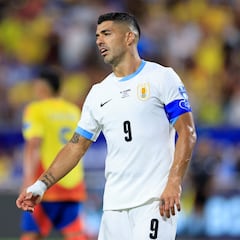Scaloni’s tried and tested method to survive without Messi
Lionel Scaloni’s team tried different things without their two top stars with De Paul the new leader of the side.

Argentina have officially begun a new chapter, albeit with some bittersweet emotions as they bid farewell to Ángel Di María, who will no longer represent his national team. Lionel Messi will also be absent from this match due to injury. Remarkably, 141 matches (spanning 18 years, 1 month, and 20 days) have passed since neither Messi nor Di María played in an official match. As such, Lionel Scaloni is already laying the groundwork for the future.
In the first half, Argentina displayed organisation but lacked the spark to find a breakthrough. However, everything changed in the second half, when a brilliant move from Rodrigo De Paul led to the opening goal.
Julián Álvarez then provided a moment of calm with the second, and Paulo Dybala sealed the win with a fantastic strike, making it 3-0.
This is the new Argentina, without its iconic stars.
Nominated for the 2024 Men's Team Coach of the Year Trophy
— Ballon d'Or (@ballondor) September 4, 2024
Lionel Scaloni @Argentina-@AFASeleccionEN #ballondor #coachdelannee pic.twitter.com/KrSvSjE6j2
De Paul and Mac Allister: the new leaders
Rodrigo De Paul delivered a standout performance against Chile. Not only did he take charge of orchestrating play, but he also maintained his defensive duties, covering both ends of the pitch. With eight recoveries and five goal-scoring opportunities created, De Paul was the best player on the field and appears to be thriving in this system without the veteran stars.
Alexis Mac Allister, who also contributed to the opening goal, embraced the creative role as well. His ability to push forward and get into the box helped to open up spaces, something he hasn’t done as frequently at Liverpool.
A back three formation for Argentina
Argentina’s use of a three-man defensive line hadn’t been seen since their World Cup quarter-final against the Netherlands, and this setup was only used by Scaloni in the first half. Otamendi, Romero and Lisandro Martínez successfully managed to stifle the few attacking opportunities that Chile carved out. In the second half, Argentina reverted to a back four which provided more fluidity in attack as the midfielders pushed forward through the middle.
Lautaro Martínez and Julián Álvarez shine in attack
Both Lautaro Martínez and Julián Álvarez found the back of the net, showing just how important their styles and profiles are in Argentina’s attack. Without Messi and Di María, the two strikers were able to focus more on goal-scoring rather than creating spaces for Messi to exploit.
“They’ve played together before, and they can do it again. It depends on our tactics and the circumstances of each match,” said Scaloni before the game against Chile.
Recharging energy for our next challenge 🔋 pic.twitter.com/Jk9GQd7jSj
— Selección Argentina in English (@AFASeleccionEN) September 6, 2024
Related stories

Messi due back after international break

Suárez's final Uruguay farewell
For the first time since Argentina’s clash with Brazil at the Maracanã in November, Argentina played with four central midfielders: Lo Celso, Mac Allister, Enzo Fernández, and De Paul. This formation worked brilliantly, and the players shone against Chile. The introduction of Dybala into the side allowed Argentina to play more through the middle areas of the pitch and rely less on using the wings as outlets for their attacks.
Argentina’s last two goals were the result of pressure in higher areas, with the team’s speed and aggression in the final third causing trouble for Chile at the back. Colombia will need to be cautious, as Argentina’s midfielders, wingers, and strikers are relentless in their press, making it difficult for opponents to play out from the back.
Complete your personal details to comment